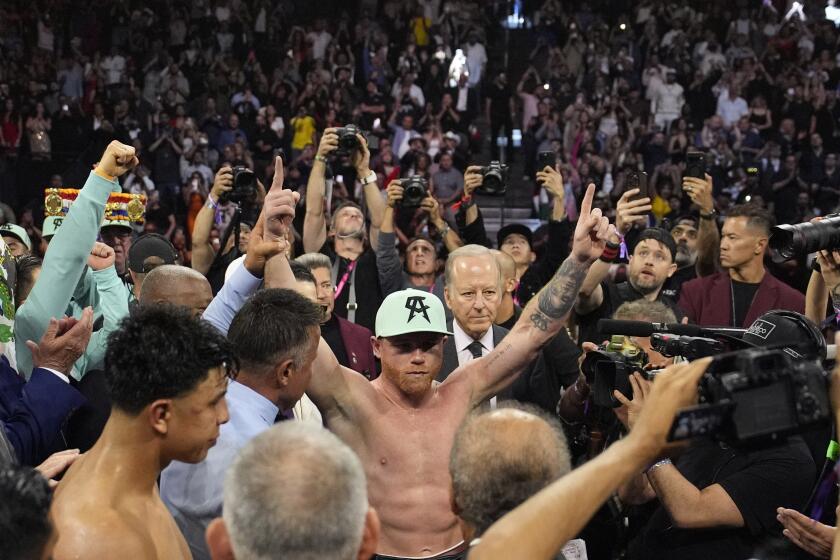A JUDGMENT CALL
Somewhere along the line, Gordon Riese figures, college football fans got the wrong idea about instant replay.
An official surrounded by video screens, analyzing close calls from various angles, running the action backward and forward in slow motion -- it sounds high tech and nearly foolproof.
It doesn’t always work that way.
Sometimes the official doesn’t have the camera angle he needs or adequate time to view all the shots between plays. Sometimes he spots a mistake that he can’t reverse because of strict rules. And in a system only a few years old, the men in the booth occasionally struggle with a task very different from the work they used to do as field officials.
“You’re learning on the job,” Riese said. “Maybe what you don’t know is going to jump up and bite you.”
That’s what happened to him during the Oklahoma-Oregon game in September. As a Pacific 10 Conference replay official, he presided over a botched call on an on-side kick that cost Oklahoma an apparent victory.
The resulting uproar sent Riese -- a respected field official -- into abrupt retirement and made him a national lightning rod for complaints about instant replay.
“It impacted how everyone viewed the season,” said Kevin Weiberg, commissioner of the Big 12 Conference, which includes Oklahoma. “I think it created an impression throughout the year that there was a problem.”
Statistics show instant replay suffered relatively few miscues amid thousands of plays this fall. But conference executives know the system is controversial and fans will be watching for more glitches as the holiday bowl season heats up.
“They’ll take one play and taint the whole system with a broad brush,” said Dave Parry, the NCAA’s national coordinator of football officials. “That’s oversimplifying the matter.”
*
Eleven major conferences -- from the Big East to the Pac-10 -- played 738 games this fall, three-quarters of which were paused for at least one review.
Of the 1,063 calls scrutinized, a quarter were reversed, according to statistics compiled by Jeff Hurd, a senior associate commissioner with the Western Athletic Conference.
Though some reviews might have seemed agonizingly long, officials say the average wait was 1 minute 49 seconds. The Pac-10 averaged 2:02, skewed in part by a convoluted double-review in the Oregon-USC game that stretched about 15 minutes.
These numbers sound reasonable enough, but they do not begin to address the passions aroused by instant replay. As USC quarterback John David Booty said: “When it helps your team, you like it. When it hurts your team, you don’t.”
Conference executives suspect the biggest misconception about instant replay is its supposed infallibility, the notion that technology should get every call right. They compare the system to an appellate court, another layer of officiating that can suffer its own brand of foibles.
“Some people assume you get a video image and that’s all you need,” said Nick Carparelli Jr., a Big East associate commissioner. “The reality is, there’s a lot of decision-making and interpretation by the replay official.”
*
When most major conferences adopted instant replay two years ago -- two waited until this season -- they hired veteran officials to work the booths. Each replay official was assigned two assistants to help with details and operate video equipment.
The crews attended seminars where they were taught a new skill set. Before, as field officials, they kept a narrow focus, watching only the offensive backfield or defensive secondary, for example. Now they learned to follow the ball because that is where most questionable calls arise.
Catch, no catch. Fumble, no fumble.
They also discovered that stressful decisions are not limited to those few instances when the game is stopped for review.
The booth official must analyze every play, asking two questions. Was there a potential mistake? If so, did the impact of the play warrant hitting the buzzer, alerting the referee to stop the game?
The decision is easy on a two-yard run off tackle, but a surprising number of plays require scrutiny. And the official must decide in 40 seconds or less, because once the next play begins there is no turning back.
Even in a televised game with numerous cameras, “You’re kind of at the mercy of what the television producer is going to show you,” Riese said. “The maximum you can see is three [angles]. If they’re in the no-huddle, you’re going to see it once.”
If the play is stopped for review -- or a coach uses his one challenge -- the pressure only increases.
The clock is ticking, teams and fans waiting for a decision. Viewers at home might be watching the same replays, forming their own opinions. They might also see an obvious mistake that the booth official -- like an appellate judge confined to certain issues of law -- is not allowed to address.
“That’s another misconception on the part of many fans,” Weiberg said.
While all of this is going on, the replay official is looking for “indisputable video evidence,” a visual image compelling enough to overturn the ruling on the field.
Implied is an exactitude that does not exist. What looks indisputable to one set of eyes might seem less convincing to another.
On close touchdown plays, for example, the camera angle is often slightly off-center, making it difficult to judge if the ball crossed the line.
“It’s like good art; you know it when you see it,” said Rogers Redding, who coordinates officiating in the Southeastern Conference. “That’s always going to be a judgment call.”
*
Instant replay made one if not two mistakes during last season’s national championship game at the Rose Bowl, officials say.
On one play, Texas quarterback Vince Young was tackled before lateraling to a teammate for a touchdown. On another, USC tailback Reggie Bush might have pitched the ball forward, thus negating a fumble.
Neither potential error was caught because of crossed wires in the booth. While television viewers watched several replays at home, officials were left with less-definitive angles.
Similar glitches affected other games this season, including, Riese said, Oklahoma-Oregon. The very technology heralded as a safeguard against bad calls can be as fallible as human observation.
“People don’t realize we’re in just our second year,” said Verle Sorgen, who oversees Pac-10 football officiating. “That’s not meant as an excuse; it’s a fact of life.”
Even if all the monitors are hooked up correctly, instant replay’s effectiveness varies from stadium to stadium.
In a nationally televised game, officials can summon shots from eight or nine angles. But regional telecasts might have significantly fewer cameras and some games -- especially in small conferences such as the Western Athletic and Sun Belt -- aren’t televised at all.
“We have to rely on in-house,” said Hurd of the WAC.
That means the Jumbotron camera or low-tech video cameras that teams use to record game film.
“If you don’t have the camera angles to get the play,” Hurd said, “then you don’t have indisputable evidence.”
Video equipment to view replays also varies widely. Several large conferences use DVSport, a top-of-the-line system that costs more than $15,000 and allows officials to manipulate images by touching the screen.
The Pac-10 uses the XOS system, less sophisticated and cheaper by half. Small conferences have systems not unlike the TiVo boxes that fans have in their living rooms.
Parry, the national coordinator who serves the same role for the Big Ten, would like to see everyone use identical equipment. But others don’t see that change coming.
“With some programs, they have a concern about expenditures,” said Grant Teaff, executive director of the American Football Coaches Assn. “They’re going to have to live with less access.”
*
Conference executives know that fans watch pro football and see a better brand of instant replay.
NFL officials have more experience with the system, more cameras and the best technology in the booth. They also know how to sell it.
In the pros, the referee ducks under that black hood and makes the final decision. So when he announces the ruling, he can give fans a better explanation. In college, the referee merely states the outcome in strict, NCAA-mandated language.
Still, college officials believe their version of instant replay will improve with each season.
“I think replay officials are getting better,” Weiberg said. “Many of these folks have probably been in this role for less than two dozen games.”
When coaches, and executives from the conferences and the NCAA gather at various meetings in the off-season, they will address numerous issues regarding the system.
The SEC wants to see stoppages shortened. The Pac-10 wants to look at the overall number of reviews, clarifying guidelines so that games are paused only for plays that have a real impact on the outcome.
Nationwide, there seems to be a growing desire for standardized training.
“Right now, there isn’t much of a mechanic’s manual,” Weiberg said. “We’ve left it up to each conference.”
Despite the controversy, instant replay has plenty of supporters within the game.
Field officials like that it takes the ultimate burden off their shoulders -- can anyone name the one who blew the Oklahoma-Oregon call? Coaches might grouse occasionally, but want a safety net against losing games on bad calls.
“A lot of us remember getting those nice letters from the conference office on Monday,” Teaff said. “Boy, you sure were right about that call, sorry for the loss and good luck next season.”
For now, it seems, only a few voices -- including USC Coach Pete Carroll -- want to see the system scrapped and college football returned to the old ways.
Count Riese among the detractors.
Thick-skinned from all his years as an official, he nevertheless gets emotional about what happened that day in Oregon. He wonders about the limitations of technology and muses that replay officials have been handed an unreasonable task.
“I think the game should be left with the players and the officials on the field,” he said. “That’s the way it was played for so many years and that’s the way it should be played.”
*
More to Read
Get our high school sports newsletter
Prep Rally is devoted to the SoCal high school sports experience, bringing you scores, stories and a behind-the-scenes look at what makes prep sports so popular.
You may occasionally receive promotional content from the Los Angeles Times.







